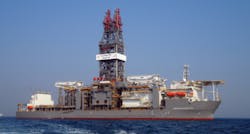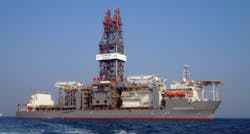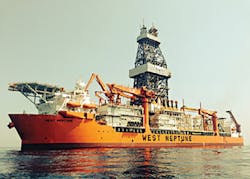Gulf of Mexico deepwater discoveries down, but not out
Bruce Beaubouef
Managing Editor
It has been a tough year for deepwater drilling in the US Gulf of Mexico. The number of drilling rigs in the Gulf is down by three, from 22 to 19, compared to last year, according to the Baker Hughes rig count of Dec. 15, 2017. And that number is down by 39 compared to three years ago, when the US active offshore rig count stood at 58.
Transocean’s ultra-deepwater drillshipDeepwater Invictus spudded BHP Billiton’s Wildling-2 in April. (Courtesy Transocean)
Still, there have been a number of important deepwater discoveries made and announced over the past year.
In December 2016, Anadarko announced that its Warrior exploration well encountered more than 210 ft of net oil pay in multiple high-quality Miocene-aged reservoirs. The Warrior discovery is approximately 3 mi (5 km) from the Anadarko-operated K2 field and is expected to be tied back to its Marco Polo production facility. The company and partner Ecopetrol drilled a successful appraisal well, Warrior-2, in 2Q 2017.
Anadarko also announced that it had encountered more than 90 ft of high-quality oil pay in a Pliocene-aged reservoir at its Phobos appraisal well, located approximately 12 mi (19 km) south of the Lucius spar. A tieback from Phobos to Lucius is being studied.
In May 2017, Anadarko reported that it had drilled the first development well at Horn Mountain, encountering more than 70 ft of net oil pay. It also reported that the Calpurnia exploration well in Green Canyon block 25 encountered nearly 60 ft of oil pay in Miocene-aged sands. Calpurnia is expected to be tied back to one of Anadarko’s nearby operated facilities in the Green Canyon protraction area.
In August, BHP Billiton reported that it had made an oil discovery in multiple horizons at its Wildling-2 appraisal well in the Green Canyon area. The Wildling field is located in Green Canyon block 530 in 4,035 ft of water. The Wildling-2 well was spudded by Transocean’s ultra-deepwater drillshipDeepwater Invictus in April.
In September, LLOG Exploration Co. LLC announced that Seadrill’s ultra-deepwater drillshipWest Neptune would drill and complete two wells as part of its Buckskin project in the deepwater Gulf of Mexico. The West Neptune was scheduled to move to the Buckskin location in 4Q 2017.
The Buckskin field is located in Keathley Canyon blocks 785, 828, 829, 830, 871, and 872, in 6,800 ft of water. The Keathley Canyon 872 No. 1 discovery well at Buckskin was drilled by Repsol in 2009 to a depth of 29,404 ft and encountered 400 ft of net pay in the Upper and Lower Wilcox formations. Three subsequent appraisal wells drilled in Keathley Canyon blocks 785 and 829 encountered an average of 375 ft of high-quality oil pay in the Upper Wilcox. The company estimates Buckskin has 5 Bbbl of oil in place.
Seadrill’s ultra-deepwater drillshipWest Neptuneis scheduled to drill two wells as part of LLOG’s Buckskin project. (Courtesy Seadrill Ltd.)
LLOG has been active in several deepwater areas of the Gulf, and issued a general update on its drilling programs in September. The company notes that from January 2016 to August 2017, it had made 12 discoveries in the deepwater Gulf. A quick rundown of some of this activity is listed below.
• The Claiborne discovery in Mississippi Canyon block 794 is located in 1,500 ft of water and was drilled to a total depth of 24,000 ft and targeted multiple subsalt, oil-bearing Miocene sands. The discovery well was drilled by LLOG as operator in 2015 and was successfully appraised with a second well in late 2016. Both wells have been completed and are being tied-back to the Walter-operated Coelacanth platform on Ewing Bank 834.
• The LaFemme discovery in Mississippi Canyon block 427 is located in 5,800 ft of water and was drilled to a total depth of 13,000 ft and targeted multiple Upper Miocene reservoirs. The discovery well was drilled by LLOG as operator in mid-2016 and encountered more than 175 ft of net oil pay and was successfully appraised by a follow up well in later that year. Both wells have been completed and will be co-developed with the Blue Wing Olive discovery and tied back to the LLOG-operated Delta House facility on Mississippi Canyon block 254.
• The Blue Wing Olive discovery is located in Mississippi Canyon blocks 427-471, also in 5,800 ft of water, and was drilled to a total depth of 17,000 ft and targeted multiple Upper Miocene zones. The discovery well was drilled by LLOG as operator in mid-2016 and will be completed in two oil and natural gas reservoirs. The company is currently completing the Blue Wing Olive well. First production is expected in mid-2018 from both the LaFemme and Blue Wing Olive developments.
• The Red Zinger discovery in Mississippi Canyon block 257 is located in 6,000 ft of water and was drilled to a total depth of 19,000 ft and found multiple Upper Middle Miocene targets. The discovery well was drilled by LLOG as operator in 2016. Red Zinger will be tied-back to the LLOG-operated Delta House facility. First production is expected in the second half of 2018.
• Marmalard East in Mississippi Canyon block 301 is a field-extension well in 5,300 ft of water that was drilled and completed by LLOG as operator in 2Q 2017. The well was drilled to a total depth of 18,000 ft and targeted Miocene sands and encountered more than 50 ft of net oil pay. The well was brought onto production through the Marmalard subsea infrastructure system to the Delta House facility at a rate in excess of 12,000 b/d of oil.
• Crown & Anchor, a previously-announced two-well discovery in 4,200 ft of water in Viosca Knoll blocks 959, 960, 1003 and 1004, was drilled by LLOG as operator in 2015 to a total depth of 14,000 ft targeting multiple Upper Miocene sands. Both wells have been completed and will be tied back to the Anadarko-operated Marlin facility in Viosca Knoll blocks 871 and 915. First production is expected in 2Q 2018.
For more on these and other drilling efforts in the Gulf of Mexico, please see the 2018 Status of US Gulf of Mexico deepwater discoveries survey starting on page 27.


